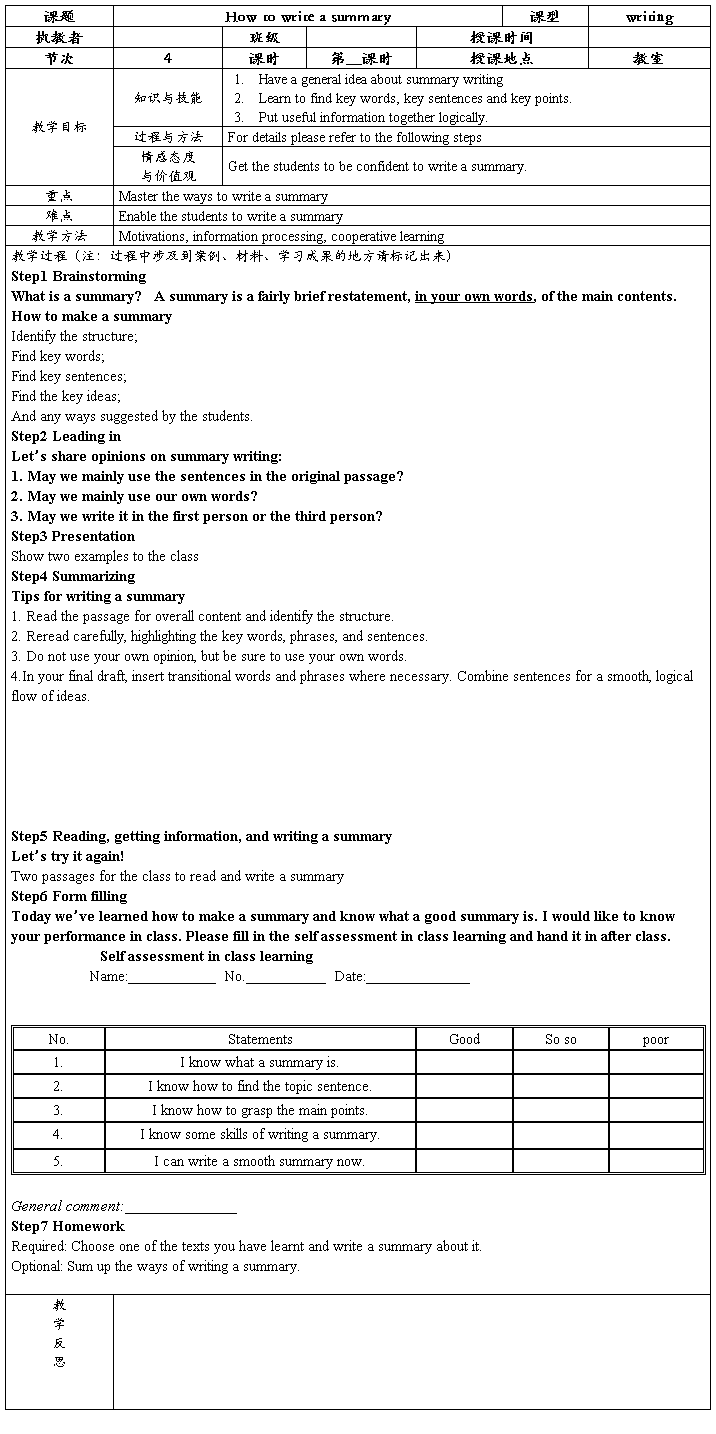How to write a summary
How to write a summary
1. Definition
By summary, we mean a brief restatement, in your own words, of the content of a passage, an article, a chapter or a book.
2. key points of a summary:
A summary should be brief, complete, accurate, coherent and objective.
Brief: omit unnecessary details like examples, explanations and other unimportant information. Length: 1/4---1/3 of the original text
Complete: to include all the main and supporting points delivered in your own words. Accurate: to give the same attention and stress to the points as the author does.
Coherent: rather than an outline listed as key words and phrases, a summary is a paragraph with necessary transitions and function structures to make it flow.
? first, in the first part, in the introductory part
? second, next, in the second part
? then, afterwards, after that, in addition to that, also, furthermore
? finally, at last, in the end, as a conclusion, on the whole, in a word, to sum up, last but not
least,
? as a result, so the content of the original passage only.
3. Steps to write a summary
1) skim the text to find out the general theme
2) analyze the text's structure to divide it into several sections, find out the main idea of each section and write it out briefly with your own words. (one sentence)
3) write down the key supporting points for each main idea without involving minor details.
4) organize the main and related supporting points in a logical order with necessary transitions to achieve coherence.
5) proofread for grammatical, spelling and punctuation mistakes. At the beginning of a summary, we usually elicit引出 the author's name and the name of the chapter/ article.
A Summary of “National Security Justifies Censorship”
By Roger S. Thomas The article “National Security Justifies Censorship” by Elmo R. Zumwalt and James G. Zumwalt, appears in Censorship, a book in the Opposing Viewpoints Series. The article asserts that information that is secret and vital to the security of the nation should not be released to the press. The arguments made by Zumwalt Senior and Junior are summarized below. Although many journalists contend that the First Amendment guarantees unrestricted printing freedom, the authors believe the press has gained more power than the framers of the Constitution foresaw and therefore neglected to install safe guards that would protect national security. According to the authors, the power of the media has gone far past what the constitutional framers expected; consequently, several acts since the writing of the Constitution have been implemented to deal with the lack of protection regarding national security. The authors continue to affirm that even though significant risk exists when confidential information is released to the press, this danger has remained unresolved by the courts.
The authors cite an example to prove this point. The CIA during the Reagan administration recognized Muhamar Quadaffi as a known terrorist and a potential threat to national security in a classified document. The Washington Post somehow had the document disclosed to them, and they soon published the information. Several months after the operation had been abandoned, the CIA found Quadaffi responsible for the bombing of a West Berlin discotheque. Military action had to be taken because of the earlier release of the classified document. The operation incurred military casualties.
The authors then offer a two-part solution: (1) make the publication of classified information a punishable offense, and (2) incorporate a “code of ethics” into media guidelines that safeguards national security. The paper ends by discussing how ethics are the responsibility of good journalism. Elmo R. Zumwalt and James G. Zumwalt assert that the media are overpowered and the national security is underprotected. They believe that the government and the media must take steps to assure a disaster does not occur.
SPECIAL NOTES:The subtitles in this sample add clarity, but most instructors either do not require them or prefer that they are not used in a summary.
第二篇:How to write a summary 英语作文 教案模板
 珠海市第x中学教案
珠海市第x中学教案

-
150篇Argumentative Essay Topics
150BestArgumentativeEssayTopicsPostedonJanuary24th20xxLookingforeffectivean…
-
How to write an argumentative essay
Howtowriteanargumentativeessay如何写英语议论文不同观点列举型选择型Thereisawidesprea…
-
argumentative essay
ArgumentativeEssaysSummaryTheModesofDiscourseExpositionDescriptionNarration…
-
argumentative essay
HUDSONCOLLEGEArgumentativeEssay400academicskillsTeacherMariaAimimirJunxiang…
-
Argumentative Essay Sample
ArgumentativeEssaySampleEconomicGrowthandEnvironmentalDamageThoughnowadaysi…
-
The probation period work summary report
TheprobationperiodworksummaryreportRespectleadershipHelloInaninstanttocompa…
-
英文summary写作范例
ArticleChildrenMustbeTaughttoTellRightfromWrongWilliamKilpatrickManyoftoday…
-
怎么写英文摘要summary
摘要是对一篇文章的主题思想的简单陈述它用最简洁的语言概括了原文的主题写摘要主要包括三个步骤1阅读2写作3修改成文第一步阅读A认真阅…
-
summary 范文
OriginalMyneighbor39schildrenloveplayinghideandseekasallchildrendobutnoonei…
-
英文读写summary范文
ThesummaryofNiceGuysAndGirlsFinishTogetherInNicholasDKristofsNiceGuysAndGir…